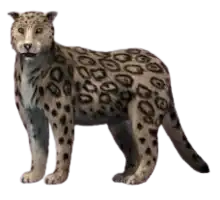| Panthera blytheae | |
|---|---|
 | |
| Life restoration | |
| Scientific classification | |
| Domain: | Eukaryota |
| Kingdom: | Animalia |
| Phylum: | Chordata |
| Class: | Mammalia |
| Order: | Carnivora |
| Suborder: | Feliformia |
| Family: | Felidae |
| Subfamily: | Pantherinae |
| Genus: | Panthera |
| Species: | †P. blytheae |
| Binomial name | |
| †Panthera blytheae Tseng et al., 2014 | |
Panthera blytheae is an extinct species of pantherine felid that lived during the late Messinian to early Zanclean ages approximately 5.95–4.1 million years ago.The first fossils were excavated in August 2010 in the Zanda Basin located in the Ngari Prefecture on the Tibetan Plateau; they were described and named in 2014.[1]
Characteristics
Only a single fossil specimen of a Panthera blytheae cranium has been found. However, evidence shows that the species has a number of features common in other Panthera species, including a "frontoparietal suture located at the postorbital constriction", and an "absence of an anterior bulge overhanging the infraorbital canal". Its size is thought to be on par with that of the clouded leopard. It is about 10% smaller than the snow leopard. However, this is purely based on the relative sizes of the cranium, so this may be slightly inaccurate.[1]
Relation to other Panthera species
Some researchers questioned the classification of P. blytheae to the genus Panthera based on a limited comparisons to other species, and as lacking features that comply with Panthera features.[2] One researcher, Hemmer, proposed that P. blytheae and "Miopanthera" pamiri' are distantly related to extant big cats and instead more closely related to Neofelis, and erected Palaeopanthera for both species.[3]
P. blytheae is not thought to be as closely related to the other extant species of the genus Panthera, and is therefore not believed to be the common ancestor of all pantherines. This implies that the divergence of Panthera from the rest of Felidae was much earlier, with current estimates being approximately 16.4 million years ago. Analysis of the location of P. blytheae in relation to other Panthera species indicates that Panthera arose in Central/Northern Asia or the Holarctic region of Asia, with other pantherines migrating to Europe, Africa and the Americas.[4]
As of 2023, at least two recent studies considered Panthera zdanskyi likely to be a synonym of Panthera blytheae, noting that its proposed differences from that species fell within the range of individual variation.[3][5]
See also
References
- 1 2 Tseng, Z. J.; Wang, X.; Slater, G. J.; Takeuchi, G. T.; Li, Q.; Liu, J.; Xie, G. (2014). "Himalayan fossils of the oldest known pantherine establish ancient origin of big cats". Proceedings of the Royal Society B: Biological Sciences. 281 (1774): 20132686. doi:10.1098/rspb.2013.2686. PMC 3843846. PMID 24225466.
- ↑ Geraads, D.; Peigné, S (2017). "Re-appraisal of 'Felis' pamiri Ozansoy 1959 (Carnivora, Felidae) from the upper Miocene of Turkey: the earliest pantherine cat?". Journal of Mammalian Evolution. 24 (4): 415–425. doi:10.1007/s10914-016-9349-6. S2CID 207195894.
- 1 2 Hemmer, H. (29 March 2023). "The evolution of the palaeopantherine cats, Palaeopanthera gen. nov. blytheae (Tseng et al., 2014) and Palaeopanthera pamiri (Ozansoy, 1959) comb. nov. (Mammalia, Carnivora, Felidae)". Palaeobiodiversity and Palaeoenvironments. doi:10.1007/s12549-023-00571-5. S2CID 257842190.
- ↑ Qiu, Jane (12 November 2013). "Himalayan fossils point to Asian origin of big cats". New Scientist. Retrieved 2016-01-10.
- ↑ Jiangzuo, Qigao; Wang, Yuan; Ge, Junyi; Liu, Sizhao; Song, Yayun; Jin, Changzhu; Jiang, Hao; Liu, Jinyi (2023). "Discovery of jaguar from northeastern China middle Pleistocene reveals an intercontinental dispersal event". Historical Biology. 35 (3): 293–302. doi:10.1080/08912963.2022.2034808. S2CID 246693903.